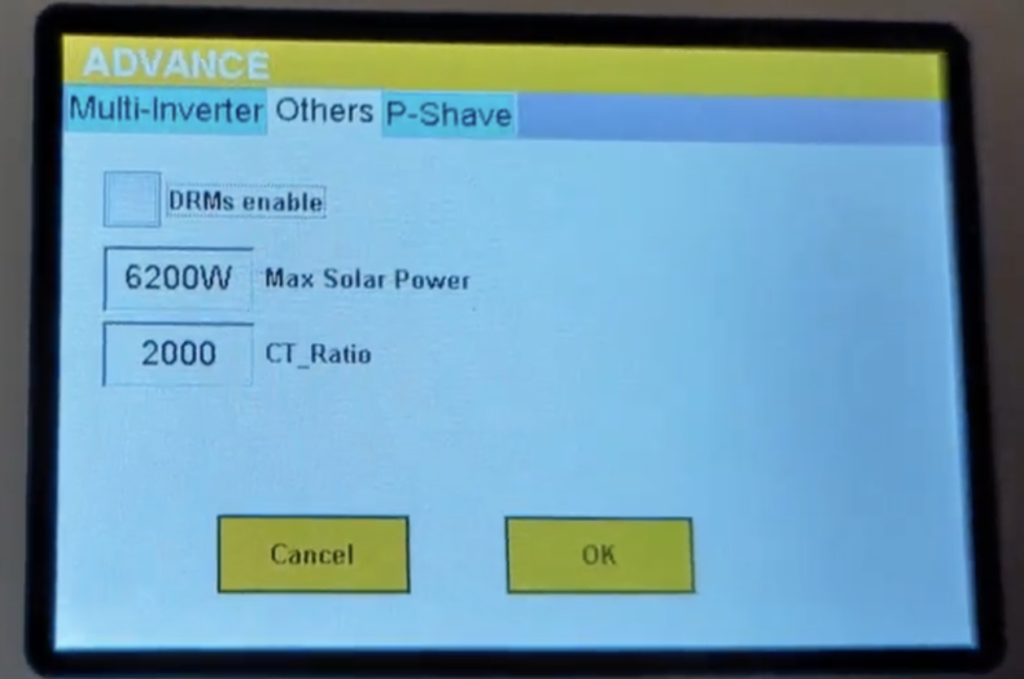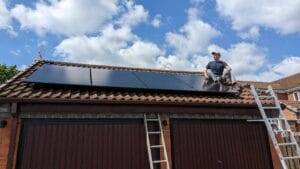The Hidden Capability of Your Sunsynk 3.6
The Sunsynk 3.6 inverter is rated, as the name suggests, to convert 3.6kW of solar energy into usable AC electricity. However, what many homeowners don’t know is that this compact powerhouse can handle up to 7kW of DC input from your solar panels!
This isn’t a mistake or an overstatement – it’s a legitimate feature built into the inverter that, when configured correctly, can dramatically increase your system’s performance, especially during the UK’s variable weather conditions.
How Is This Possible?
The key lies in understanding the difference between AC and DC power:
- Your solar panels produce DC (Direct Current) electricity
- Your home runs on AC (Alternating Current) electricity
- The inverter’s 3.6kW rating refers to its maximum AC output
- However, its DC input capacity is much higher at 7kW
Under optimal conditions with the right setup, your Sunsynk 3.6 inverter can take in up to 7kW from your solar array, using what it needs for immediate AC conversion while directing excess DC power to battery storage.
Two Essential Requirements for Maximising Solar Power
To unlock this potential, your system needs to meet two specific conditions:
- An Oversized Solar Array: Your panel capacity must exceed the inverter’s AC rating. For example, having 5-7kW of solar panels connected to a 3.6kW inverter.
⚠️ Be careful here, oversizing can be dangerous if not done correctly. Always consult a professional if you are not sure. - DC Power Storage: You need somewhere to direct excess DC power – typically batteries. A battery system of at least 5kWh capacity is recommended, though larger capacities (10-15kWh) will provide more flexibility.
This configuration is particularly beneficial in the UK, where seasonal variations significantly impact solar production. With oversized arrays, you can capture more energy during limited sunshine hours in autumn, winter, and spring, while fully utilising your system’s capacity during summer months.
Finding the “Max Solar Power” Setting
The magic happens in a little-known configuration option called the “Max Solar Power” setting, found under Advanced Settings in your Sunsynk inverter’s LCD menu.
This setting determines the maximum amount of power your inverter will draw from your solar panels. When set correctly, it allows your system to:
- Draw up to 7kW from your solar array (if available)
- Convert up to 3.6kW to AC for immediate use
- Direct excess DC power to battery storage
- Export surplus energy to the grid (if applicable)

Many system owners unknowingly leave this setting too low, especially if they’ve expanded their solar array over time without reconfiguring the inverter.
Remember, this adjustment is only beneficial if you have:
- More than 3.6kW of solar panels installed
- Battery storage connected to your system
Real-World Benefits of Maximising Your Sunsynk 3.6 Inverter
Properly configuring your system can lead to significant improvements:
- Increased Energy Production: Capture up to double the solar energy during peak production periods
- Better Winter Performance: Get more usable power during shorter, less sunny days
- Improved Battery Charging: Direct excess DC power to your batteries more efficiently
- Greater Self-Consumption: Reduce reliance on grid electricity
- Enhanced Return on Investment: Extract maximum value from your solar panel investment
Why Choose the Sunsynk 3.6kW Inverter in the First Place?
Many UK homeowners, myself included, initially opt for the smaller inverters such as the Sunsynk 3.6 ECCO inverter for a compelling reason: simpler grid connection regulations.
In the UK, connecting an inverter rated at 3.68kW or less typically falls under the faster, easier G98 notification process with your District Network Operator (DNO). Going above this often requires the more complex G99 application process. (Explore upgrading from G98 to G99 here).
Beyond regulations, the Sunsynk 3.6 is a versatile and highly configurable solar inverter, capable of managing batteries, generators, and complex setups, making it a favourite for many, including those undertaking a DIY solar installation.
Why This Matters for UK Solar System Owners
The UK’s climate presents unique challenges for solar energy production:
- Seasonal Variation: Dramatic differences between summer and winter sunlight hours
- Changeable Weather: Frequent cloud cover and rain affecting solar performance
- Limited Peak Production Windows: Fewer hours of optimal production compared to sunnier countries
By maximising your Sunsynk inverter’s capabilities through proper configuration and oversizing, you can mitigate these challenges and extract more value from your investment year-round.
Is This Approach Right for Your System?
While this configuration can dramatically improve performance, it’s not suitable for every installation. Consider:
- Current Array Size: If you already have 3.6kW or less of panels, you won’t benefit from this adjustment
- Battery Capacity: Without adequate battery storage, excess DC power has nowhere to go
- DNO: Ensure you remain compliant with any Distribution Network Operator agreements regarding grid connection
Real-World Results: Seeing is Believing. Boosting Production by 40%
After correcting this setting on my system to 6200W, the difference was immediate. On a suitable day (overcast in the morning but good sun around noon, battery needing charge), I observed my inverter drawing over 4.1kW total from the panels – simultaneously exporting/powering AC loads and charging the battery significantly faster than before. This confirmed the Sunsynk 3.6 7kW DC input capability in action.

This simple check unlocked significantly more energy capture from my existing oversized solar array.
Recommendations for New Installations
Planning a new solar system? Consider these points to maximise your Sunsynk 3.6 inverter’s potential:
- Install 5-7kW of solar panels to fully utilise the DC input capacity
- Include adequate battery storage (minimum 5kWh, ideally 10kWh+)
- Configure the “Max Solar Power” setting correctly from day one
- Consider seasonal positioning to optimise year-round production
Conclusion: Don’t Leave Free Energy on the Table
The Sunsynk 3.6kW inverter is more powerful than its AC rating suggests. By pairing it with an oversized solar array and a battery bank, you can leverage its impressive 7kW DC input capacity. This allows you to:
- Maximize solar yield throughout the year, especially in the UK’s variable conditions.
- Charge your batteries much faster using excess DC power.
- Get the most value from your solar investment (see potential savings here).
If you have this setup, take a moment to verify your “Max Solar Power” setting is configured correctly (usually at its maximum). You might be surprised by the extra energy you can harvest!
Exploring solar? Check out our Start Here guide or browse Solar Energy Concepts for more insights into panels, batteries, and making the most of your system.









